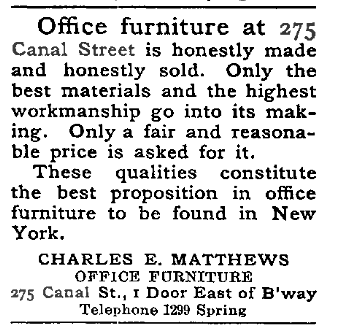On October 19, 1870 millionaire Henry E. Pellew purchased the empty "gore lot" at No. 275 Canal Street from Jonathan Edwards. It would be eight years before he developed the plot, hiring the 37-year old architect Charles Coolidge Haight to design a loft and store building in 1878.
Pellew was a highly respected and influential businessman. On February 12, as Haight was working on the plans for his new building, Pellew was a pallbearer at the funeral of Theodore Roosevelt, Sr., the father of the future President of the United States.
Completed within the year, No. 275 Canal Street exhibited strong elements of the Romanesque Revival style to which Haight repeatedly returned over the next decades. It was most evident in the arched openings of the fourth and fifth floors. The Queen Anne style made its appearance in dog tooth brickwork panels between the second and third floors and the fanciful pierced cornice designs flanked by stone gablets.
The building became home to Eastman, Bigelow & Dayton, "silk and fancy drygoods" merchants. The firm had begun as Eastman, Sheldon & Townsend in 1845; but after Sheldon was lost at sea on a return voyage from Europe in 1855, the Alden B. Bigelow and Milton P. Dayton joined Albert L. Eastman to form the new organization.
The New-York Sketch Book and Merchant's Guide noted that the firm's "chief feature" was ladies' dress trimmings. "Their assortment of these goods is always large, and of the newest styles" it said, adding "Their stock also comprises a complete assortment of Taffetas and Satin Ribbons, Bonnet Ribbons, Kid Gloves, Embroideries, &c., &c."
The firm had been in its new home only about a year when valuable silk velvet ribbon disappeared. The stolen goods were valued at more than $700--or about $18,500 in today's money. A break in the case came around October 15, 1879 when a customer informed the firm that "quantities of black ribbon, known as 'the Black Friar' brand in the original packages as imported, and bearing the trade-mark of the firm, were being offered for sale at a much lower rate," according to The New York Times.
The ribbon was tracked down to the shop of merchant tailor I. M. Witkoski. and an elaborate plot was discovered. The goods were initially stolen by a janitor, who sold them to a mattress maker, John Gurney. Gurney then resold the goods to Benjamin M. Wilkoski, the brother of the the shop's owner.
In court Wilkoski freely admitted he had purchased the ribbon and was reselling it; but said he had no way of knowing the goods were stolen. He testified that "he had taken them from a man for whom he had made several suits of clothes, in payment for the clothing." Judge Gildersleeve was unmoved and on November 17 sentenced the tailor to three years in State Prison.
The 1890's saw Casse, Lackey & Co., makers of window shades (renamed Pinney, Casse & Lackey in 1892); the Leopold Ascher Co., makers of paint and shaving brushes; and William Harvey, manufacturers of canes and umbrella handles, in the building.
 |
| The Beta Theta Pi magazine, October 1893 (copyright expired) |
In June 1899 Henry Pellew commissioned architects Horenburger & Straub to make structural improvements to No. 275, including new iron girders.
Of the 31 employees in Leopold Ascher's brush factory in 1902, only five were men. One of them was John Barkey, who lived in Brooklyn and walked to and from work over the Brooklyn Bridge. Barkey was one of thousands of workers who used the pedestrian crossing, creating what was known as the "Brooklyn Bridge crush" at rush hours.
On the evening of October 21, 1902 Barkey became caught up in what the New York Press described as a "fighting, impatient crowd." As a streetcar passed, Barkey was forced against it by the mass of pedestrians. The article explained that "as the car was in motion he could stay on his feet no longer and fell under the car. As soon as he came in contact with a wheel that tore off his toes, he dragged himself under the feet of the passing throng."
Barkey screamed in pain until Patrolman J. Flood "rescued the man from under the heels of the crowd." He was taken to the Hudson Street Hospital where his toes were amputated.
In 1902 Pinney, Casse & Lackey Company merged with the Columbia Shade Cloth Company, located next door at No. 273 Canal Street. The Charles E. Matthews office furniture company took its place in No. 275.
 |
| Batten's Wedge magazine, February 1906 (copyright expired) |
Sixty-three years after their father had purchased the property Marion and Charles E. Pellew sold No. 275 Canal Street to the Myr-Mil Holding Company in November 1933. The new owners made alterations which did away with factory space. Completed in 1935, the changes resulted in a store and showroom on the ground floor and additional showrooms on the upper floors.
Among the tenants in the 1940's was the Royal Sundries Corp., which sold novelties like the Marvo Cigarette Roller. An advertisement in The Billboard on October 6, 1945 touted its "metal sides" and offered the item "in quantities" for 5 cents each.
In 1961 a drug store operated from the ground floor. On February 20 that year the Long Island Star-Journal entitled a front page article "3-Alarmer Snarls Traffic" and reported "The fire which broke out shortly after 5 A. M. in a five-story commercial building at 275 Canal street soon raged through three floors of the structure."
While damaging the interior, the blaze left Charles C. Haight's striking facade intact. The building was renovated again in 2020 to create office space above the ground floor store.
photographs by the author



.png)
No comments:
Post a Comment